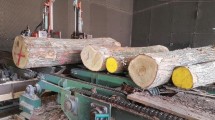Abstract
Kiln drying of radiata pine (Pinus radiata D. Don) sapwood induces a brown discolouration, commonly called kiln brown stain. Kiln brown stain generally occurs 0.5–1.5 mm under the surface of the dry sawn lumber. However, subsequent planing of the wood can expose the stain causing substantial revenue loss in the New Zealand highvalue export markets. In the present study, the effects of kiln schedule temperature, wood moisture content and kiln relative humidity on kiln brown stain formation were investigated. The results showed that kiln brown stain was greatly reduced by using kiln schedules of less than 50°C as opposed to 90°C and was also more pronounced in the kilning at 30% kiln relative humidity, than at 80% humidity. Furthermore, the occurrence of kiln brown stain tended to intensify with decreasing wood moisture content, irrespective of kiln temperature and kiln humidity used. The practical implication of this work and the mechanisms of kiln brown stain formation are discussed.
Zusammenfassung
Während der technischen Trocknung vonPinus radiata kommt es zu braunen Verfärbungen, welche 0,5–2 mm unterhalb der Oberfläche des getrockneten Holzes auftreten. Diese Verfärbungen werden erst nach dem Hobeln des Holzes sichtbar und führen zu erheblichen wirtschaftlichen Verlusten in Neu Seeland's Exportmärkten. In dieser Untersuchung wurden die Einflüsse der Trocknungstemperatur, der Holzfeuchte und der relativen Luftfeuchte in der Trockenkammer auf das Auftreten der Braunverfärbung untersucht. Die Ergebnisse zeigten, daß die Braunverfärbungen bei Trocknungstemperturen unterhalb 50°C erheblich geringer waren als bei einer Trocknungstemperture von 90°C. Braunverfärbungen traten ebenfalls weinger während der Trocknung mit einer relativen Luftfeuchte von 80% auf, als bei 30%. Weiterhin konnte gezeigt werden, daß die Intensität der Braunverfärbung mit abnehmender Holzfeuchte zunahm. Dies war unabhängig von der Trocknungstempertur und der relativen Luftfeuchte. Die Auswirkungen dieser Ergebnisse auf die Praxis und der Bildungsmechanisms der Braunverfärbungen werden diskutiert.
Similar content being viewed by others
References
Arganbright DC, Dost WA (1972) The effect of brown stain on drying characteristics of sugar pine. Proc. Western Dry Kiln Club pp. 46–53
Avramidis S, Ellis S, Liu J The alleviation of brown stain in hemfir through manipulation of kiln-drying schedules. Forest Prod. J. 43(10): 65–69
Booker RE (1995) Unpublished results. NZ FRI Wood Processing Division
Charrier B, Haluk JP, Janin G (1992) Prevention of brown discolorations im European oak occurring during kiln drying by a vacuum process: Colorimetric comparative study with a traditional process: Holz Roh Werkstoff 52(11): 433–437
Cowan D (1996) Personal communication
Fengel D (1996) Die Veränderung des Holzes und seiner Komponenten im Temperaturbereich bis 200 °C.-Erste Mitteilung: Heiß-und Kaltwasserextrakte von thermisch behandeltem Fichtenholz. Holz Roh Werkstoff 24(1): 9–14
Hinterstoisser B, Weingärtner J, Praznik W (1992) Influence of wood drying processes on the carbohydrate matrix of wood ofPicea abies. Proc. of the 3rd IUFRO International Wood Drying Conference: 217–221
Kollman F, Keylwerth R, Kubler H (1951) Verfärbung des Vollholzes und der Funiere bei der künstlichen Holztrocknung. Holz Roh Werkstoff Vol. 10: 382–390
Kreber B (1995) Unpublished results. NZ FRI Wood Processing Division
Kreber B, Fernandez M, McDonald AG (1997) Migration of kiln brown stain precursors during the drying of radiata pine sapwood. Holz forschung (in revision)
Kreber B, Byrne A (1994) Discoloration of hem-fir wood: a review of the mechanisms. Forest Prod. J. 44(5): 35–42
Laytner FL (1994) Staining radiata's reputation. NZ Forest Industries 25(4): 55
Laytner FL (1995) Unpublished results. NZ FRI Wood Processing Division
Mackay JFG, Oliveira LC (1989) Kiln Operator's handbook for western Canada. Forintek Canada Corp. Special Publication No. 31. 53pp
Millett MA (1952) Chemical brown stain in sugar pine. Forest Prod. J. 6(12): 232–236
Palmer G, Palisi K (1994) An investigation of drying problems in hoop pine. Unpublished report. Queensland Forest Service. 59 pp
Pang S (1996) Personal communication
Roper J (1995) Personal communication
Schmidt K (1986) Untersuchungen über die Verfürbungen von Eichenholz bei der technischen Trocknung. Holzforschung Holzverwertung 38(2): 25–36
Sehlstedt-Persson SMB (1995) High-temperature drying of scots pine. A comparison between HT- and LT-drying. Holz Roh Werkstoff 53: 95–99
Stutz RE (1959) Control of brown stain in sugar pine with sodium azide. Forest Prod. J. 9(12): 459–463
Terziev N (1995) Migration of low-molecular sugars and nitrogenous compounds in Pinus sylvestris L. during kiln and air drying. Holzforschung 49(6): 565–574
Wassipaul F, Fellner J (1992) Eichenverfärbungen bei der Trocknung mit niederen Temperaturen. Holzforschung Holzverwertung 44(5): 86–88
Wassipaul F, Vanek M, Fellner J (1987) Verfärbungen von Eichenschnittholz bei der künstlichen Holztrocknung. Holzforschung Holzverwertung 39(1): 1–5
Welling J (1995) Personal communication
Zavarin E, Smith LV (1962) Process of underlying discolorations of redwood (Sequoia sempervirens) during drying and in use. Forest Prod. J. 16(1): 11–17
Author information
Authors and Affiliations
Rights and permissions
About this article
Cite this article
Kreber, B., Haslatt, A.N. A study of some factors promoting kiln brown stain formation in radiata pine. Holz als Roh-und Werkstoff 55, 215–220 (1997). https://doi.org/10.1007/BF02990551
Issue Date:
DOI: https://doi.org/10.1007/BF02990551




